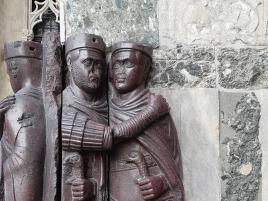Reign of Diocletian: the age of the First Tetrarchy
The period of military anarchy was ended by Diocletian of Dalmatian roots, who reorganised the administration of the Roman Empire and established a new form of imperial rule, the dominatus. Diocletian shared the power first with Maximian from 283, then also with Galerius and Constantius Chlorus from 293. Thus were diarchia (diarchy) then tetrarchia (tetrarchy) formed, i.e. the domination of first two, then four co-emperors. The four tetrarchs directed different territories of the Empire from different centres. Diocletian governed the eastern provinces and Egypt from Nicomedia (today Izmit, Turkey); Galerius managed the provinces along the Danube and in the Balkans from the centre Sirmium (today Sremska Mitrovica, Serbia); Maximian ruled over Italia, the north African and Hispanic provinces from Mediolanum (today Milan); Constantius held Britannia and Gaul under his rule from Augusta Treverorum (today Trier). Due to Diocletian’s reforms, the empire experienced important administrative changes. The territory of Pannonia was divided into four new provinces around 299 or 303: Pannonia Prima, Pannonia Secunda, Valeria and Savia. Diocletian and his co-emperors, especially Galerius (293-311) who was in charge of the provinces along the Danube, launched military campaigns against the Sarmatians living on the Great Plain bordering Pannonia (285-302). In 303 during the period of the tetrarchy the most severe persecution of Christians in the Roman Imperial Age took place.


